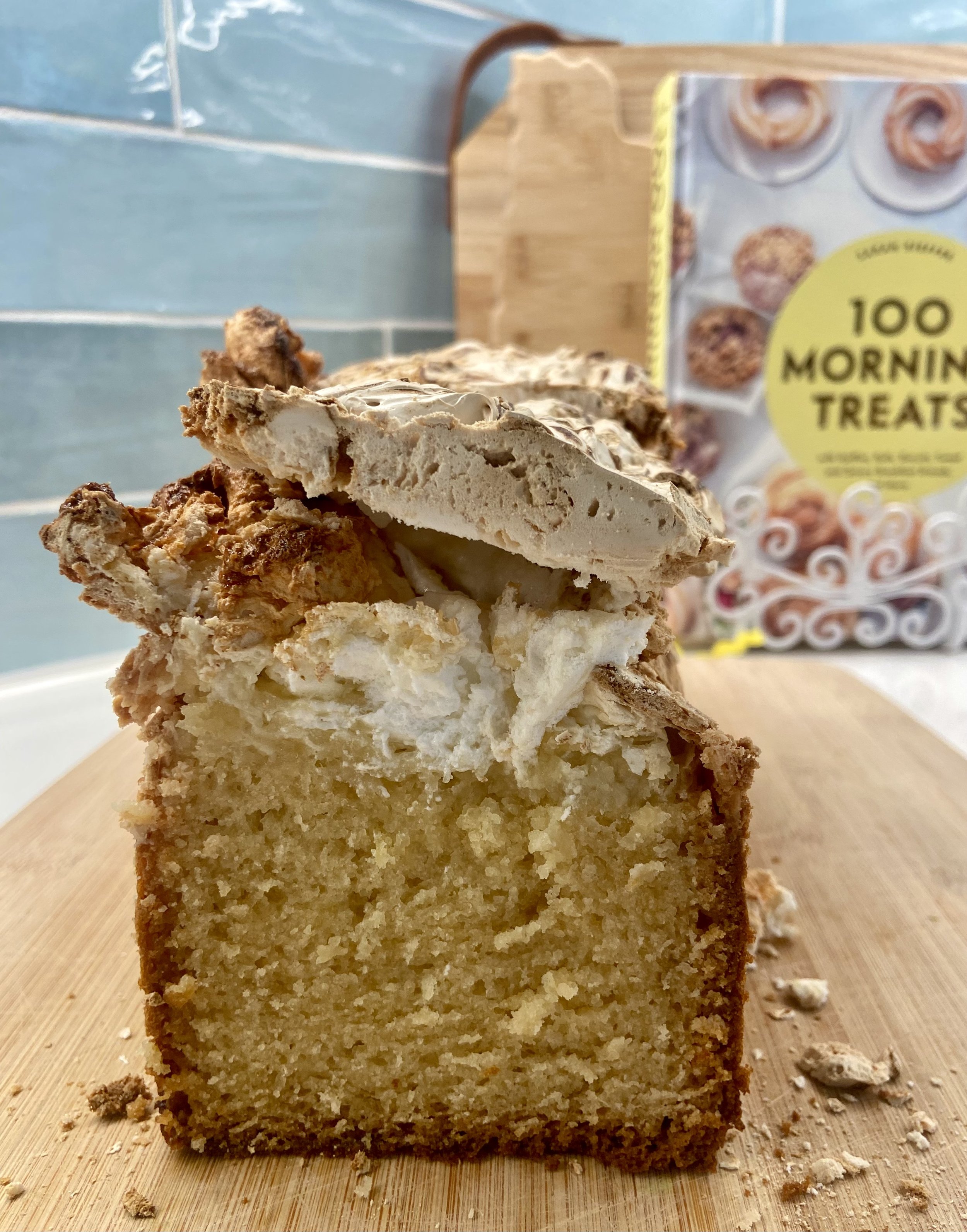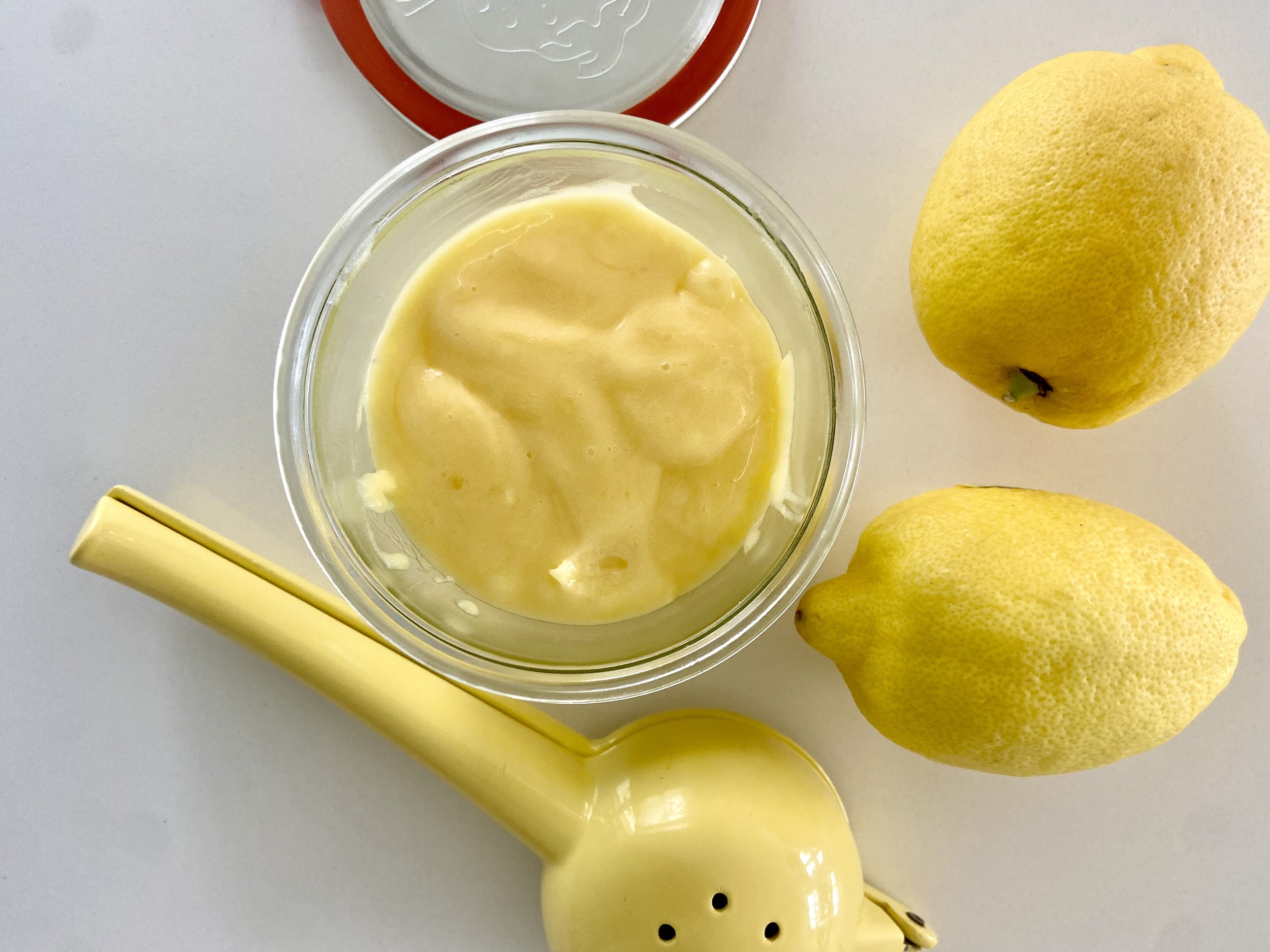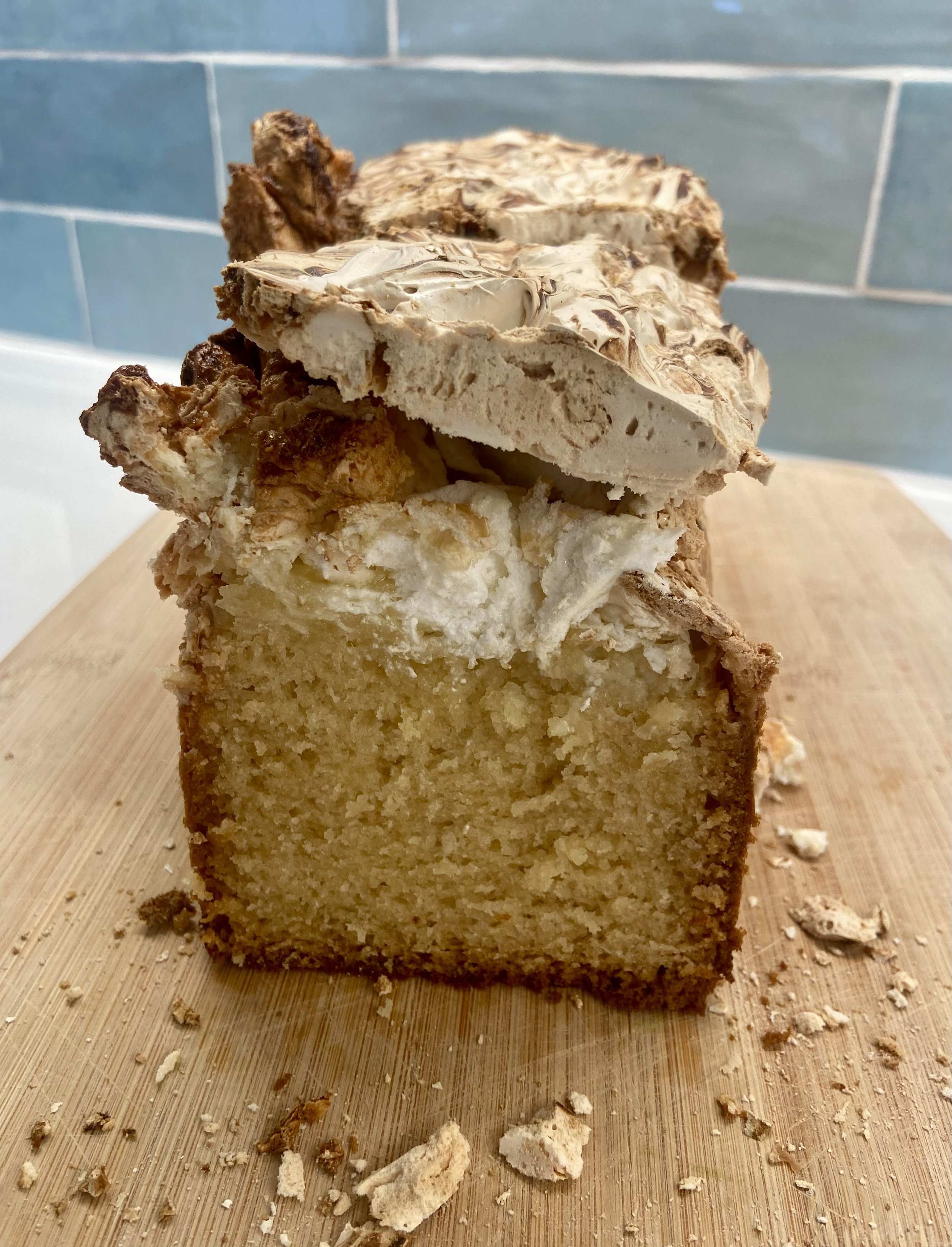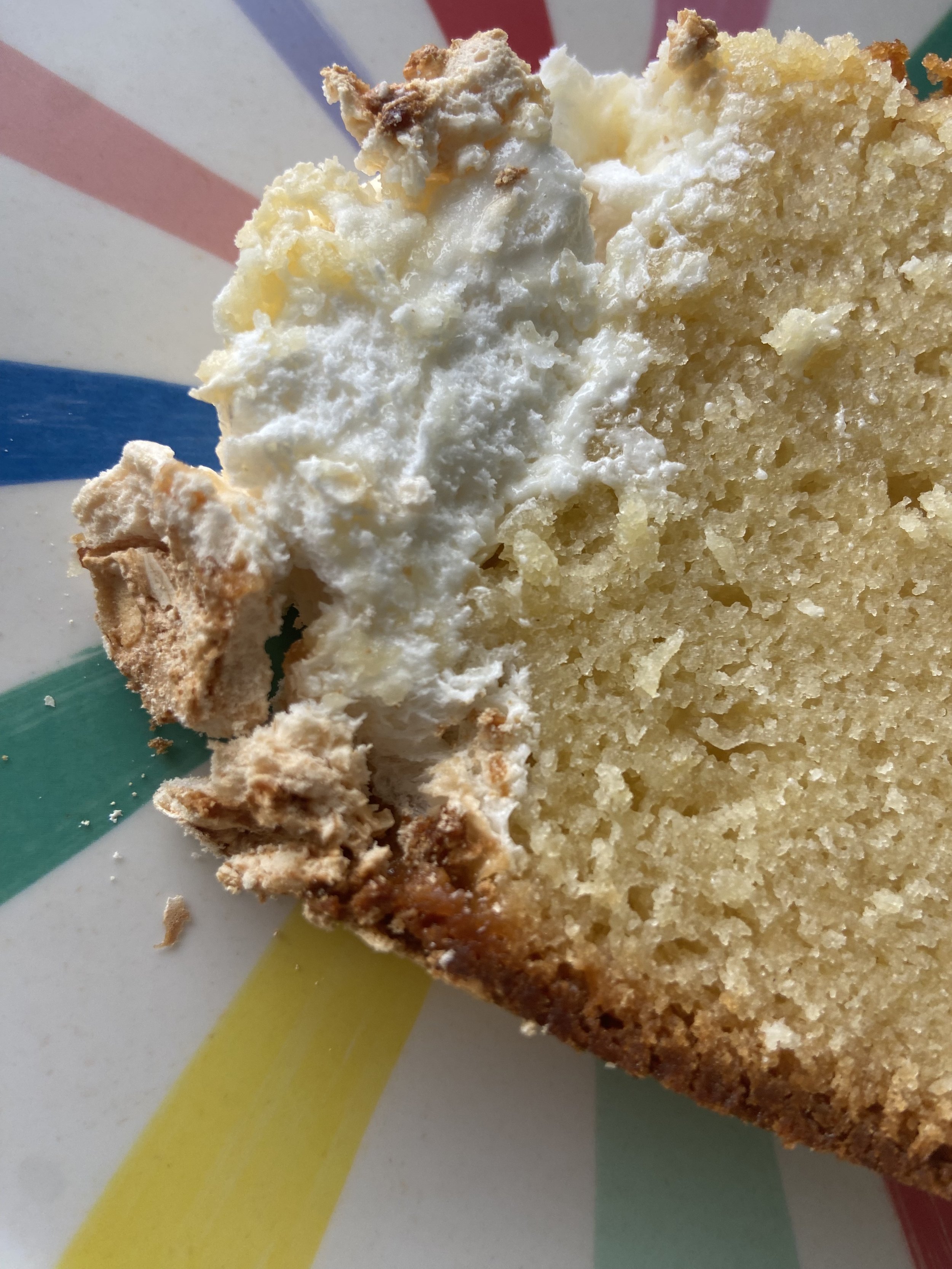Lemon Meringue Bread
I’ve recently been intrigued by a variety of recipes where the addition of meringue gives a traditional recipe a new twist. I don’t know if it’s a trend or if I’m just catching up, but I’m in love with these “fancy” riffs on cakes and breads. It may have all started with the Sweet Potato Tea Cake in Tartine: A Classic Revisited (published in 2019) where the loaf cake is topped with vanilla meringue that bakes up crisp on the outside and chewy on the inside. (Now on my November to-bake list.) I’ve also seen recipes for meringue-topped flourless chocolate cake, carrot cake, pumpkin loaf and lemon bread, with more than one citing the Sweet Potato Tea Cake as inspiration.
I was particularly drawn to both the Flourless Chocolate Meringue Cake from Claire Saffitz’ What’s for Dessert and the Lemon Meringue Bread from Sarah Kieffer’s 100 Morning Treats. Proud mama moment when my daughter made the chocolate meringue cake for her friend’s birthday last weekend, inspiring me to finally tackle the Lemon Meringue Bread.
There she is. Lemon Meringue Bread, #18 in 100 Morning Treats. Although the top wasn’t supposed to look like this, I kinda like all the layers of meringue. 🍋☺️
Each of these recipes vary in the type of meringue and the mix-in method. The lemon and sweet potato versions use Swiss meringue which results in a marshmallow-y texture. The chocolate versions do not call for cooking the egg whites and sugar before folding into the chocolate cake batter. Instead of folding all the egg white mixture into the batter, you fold in a portion and save some meringue for swirling on top before baking. Alas, making the humble flourless chocolate cake more interesting visually. Then there’s this flourless chocolate meringue cake also called Twice-Baked Chocolate Meringue Cake. It bakes part way, then the chocolate-swirled meringue (prepared similarly to Claire’s) is dolloped on top and is baked an additional amount of time. Some recipes call for swirling the meringue in with a knife or toothpick to create a marbling effect while others pile the meringue on top and ask to be folded in with a spatula.
Lemon Meringue Bread
While this loaf cake/bread is from 100 Morning Treats, be forewarned, you will want to make this the day before serving. It’s not a quick and easy morning bake and if you’re like me, it makes a mess out of your kitchen. But it’s oh so worth it. And I personally would eat it any time of day. Morning, afternoon, evening.
A side view of Lemon Meringue Bread baked in a pullman pan.
There are three main “parts.” Making the lemon curd (if you want fresh homemade and you do!). Mixing together the bread. And making the meringue. Oh and if you want the spectacular look with tall straight sides, yes you really do need a Pullman loaf pan.
I made Sarah’s recipe for lemon curd the day before and stored in fridge.
Ingredients for Homemade Lemon Curd:
8 Tbsp unsalted butter at room temperature
1 ½ cups granulated sugar
¼ tsp salt
5 large egg yolks plus 1 large egg
⅓ cup lemon juice
Making lemon curd is easy and tastes so much better!
Notes:
Some recipes call for zest to be added, but I saved my zest for the bread I was baking the next day. Feel free to add a couple tablespoons of lemon zest to the sugar when making the curd if you want an even more tart flavor.
Use organic lemons. I worry that there are pesticides or wax lurking on the skins, so even though I wash the lemons, I feel better buying organic if I plan to use the zest. Buy 4 lemons for the bread. Even if you’re not using the zest right away, you can freeze it in small containers for later. Same goes with extra juice. Pop it in the freezer.
The bread calls for 1/3 cup lemon curd, and I’d estimate this recipe made about 1 ½ cups. Note that freshly made lemon curd keeps in the fridge for 1-2 weeks. You can also pop it in the freezer for up to a year, but I think I’d use it sooner than that!
Ingredients for the lemon bread:
1½ cups all-purpose flour
½ tsp salt
¼ tsp baking soda
1½ cups granulated sugar
1 Tbsp grated lemon zest
3 oz cream cheese, at room temperature
½ cup canola oil
3 large eggs, at room temperature
1 tsp vanilla extract
¼ cup lemon juice
⅓ cup lemon curd, homemade or store-bought
Making the meringue
I’ve decided that marshmallow-y Swiss meringue is the meringue of meringues! This version of meringue involves beating egg whites and sugar together in a double boiler until the sugar is dissolved (about 4-5 minutes or to 160 degrees). It’s then removed from the heat and further beaten until doubled in volume. I find it easiest to use my bowl for the KitchenAid mixer placed over a pot with 1 inch of water, and then to transfer it to the mixer for the final whipping time. This takes 8-10 minutes, but you’ll know because it will be glossy and the bowl will be cool to the touch.
Ingredients for the Meringue:
1 cup granulated sugar
½ cup egg whites (saved from the eggs used to make the lemon curd)
⅛ tsp cream of tartar
Pinch of salt
The recipe says: “Working quickly, spoon all the meringue over the bread batter, and fold it into the batter gently with a rubber spatula six or seven times, starting at the top and dragging the meringue into the batter almost to the bottom of the pan and back up again. There should still be a visible amount of meringue on the top, which will bake up as a topping.”
Here's where I needed a video or two more hands. I found it very difficult to fold the meringue into the batter in the narrow pullman pan. It was a sticky mess! Because I couldn’t seem to fold the meringue down into the batter, the majority of my meringue sat on top or near the top of the loaf. I’m wondering if I could have folded some of the meringue into the batter in a bowl before pouring in the loaf pan. However, it wasn’t all bad because I ended up with an artistic layered meringue shell on top.
I couldn’t really cut through the hard shell on top so ended up taking that layer off.
My other “issue” is that I have double ovens, which is great, but that means that neither oven is as tall as a typical oven. So baking a tall pullman loaf pan on the center rack wasn’t a good idea. Part way through the baking time, I realized that my meringue was in danger of touching the top element. So, I had to lower the rack to the very bottom and covered loosely with foil. What this did was extended the baking time since it’s not as hot at the bottom of the oven. I ended up baking it almost 10 minutes longer as I was afraid it was too wet inside. I feared I might have baked it too long, but the cake was super moist (and delicious).
As you can see, mine did not look like the photo in the book. I ended up with a hard meringue/pavlova-type shell on top. Don’t get me wrong, it still was spectacular looking! The good news is that this was hiding a good amount of gooey marshmallow-ness (more than the book photo). In the end, I decided to discard most of the crunchy top, which exposed a beautifully swirled marshmallow/batter layer underneath.
The exposed underneath layer. It smelled like angel food cake as it baked. Mmmm.
Another photo just because.
I’d definitely make this again. I love how it looks and tastes. Next time, I’ll work on mixing in the meringue differently and bake it on the lower rack.
I’ve noticed that all these meringue cakes say they keep for 3-4 days on the counter. Sarah says the Lemon Bread is best on days 2 and 3. I’m on day 3 and I don’t know if I’ll make it past day 4. So yes, I’ll most definitely need to make it again.
Bits of soft marshmallow and crispy meringue sit on top the tart lemon cake.







